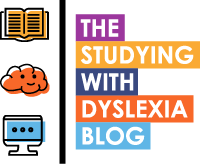When dyslexic it can be really challenging taking notes. Often these have to be taken under some kind of time pressure within school or college. This YouTube video from The Bell House shows an exercise that you can do to experience the difficulties of note taking for a dyslexic student. Read on for tips that help with note taking too.
This article is brought to you by Sonocent.
When do we take notes?
Recently I completed a course where every time I walked into the lecture the tutor had a load of notes written out on the white board. The expectation was that we would all copy them out. That process would take me about 10 minutes as my working memory seems to only remember a word or few words at best. So I was always looking up and down, trying to find my place on the board but also on my notes. This process made me feel anxious as I knew that there was a time limit at this stage of the lecture. Equally I would feel more anxious when I started to notice my peers putting their pens down and sitting up straight with an air of self-satisfaction as there were still people catching up (aka me).
Note taking can be really hard if we are copying other people’s notes or writing dictation. There is just something about time and note taking that makes the process really hard for someone with dyslexia.
The process requires focus and concentration and then on top of that processing that information.
In my example, there was no processing of information going on. I didn’t have time to process, I could only focus on trying to get the content written down. When this happens, learning doesn’t happen because I am not processing the information, I am just trying to copy it.
Experience what it is like to take notes when dyslexic.
On my Parenting Dyslexia Facebook Group, one of the parents shared the following video from the wonderful people at Bell House who do a lot of work with providing seminars about dyslexia.
The video shows dyslexia assessor, Tina Hunter, talking through a simulation of what it is like to take notes when dyslexic. It made me feel anxious just watching it as her assistant could be seen really struggling to write down the notes that were being dictated.
Have a look and tell me what you think about the video and then read on for some tips that will help with note taking…
Tips For Note Taking When Dyslexic.
Use self-awareness to manage anxiety.
OK, this is important. If you are dyslexic and in an academic setting where you will need to take notes then there is a good chance that you will experience some anxiety. You may even feel this physically before your brain even starts to think about how anxiety inducing note taking is. So if you are in a lecture or lesson and you need to take notes, if you are already feeling tense then this will make things harder for you. If you can start to recognise the signs of anxiety e.g tense neck and shoulders, feeling something in the gut etc then you can start to use strategies to calm your body down. For me, I use mindfulness which involves breathing exercises that ultimately tell the brain not to be anxious and it lowers the heart rate. I learnt my strategies by using an app called Headspace which is a great way of getting into Mindfulness and calming oneself.
Use whatever materials or technology you have to hand that helps.
The point behind note taking is to learn the content, but it can be so stressful just trying to get decent notes that sometimes the learning process goes out of the window. So what could you do to maximise learning and reduce the anxiety that gets in the way using simple solutions that you already have in place? Here are some ideas:
Take photos of the notes as they come up on the white board using your mobile phone, then you can spend more time reading them rather than worrying about copying them down.
Record the lesson or lecture (not always possible depending on which stage of education you are at, but worth a try) so that you can go back to what was said. Again the mobile phone can help and there are other technologies that can do this combined with more advanced note taking features such as Audio Note Taker from Sonocent.
If you have access to Microsoft Office 365, then I recommend Microsoft OneNote as a tool for collating all your notes. You can save all photos and type or handwrite (using a stylus) on them. I use this a lot for all my note taking and I can easily get to my notes which saves time and reduces stress for me.
Show yourself some love and know that finding strategies that work for you is a process. If a strategy doesn’t work out then just try another one, you haven’t failed, you have simply learnt about a strategy that hasn’t worked for you.
I hope that you have found this article useful. Please comment below if you have. I really want to know your thoughts.




